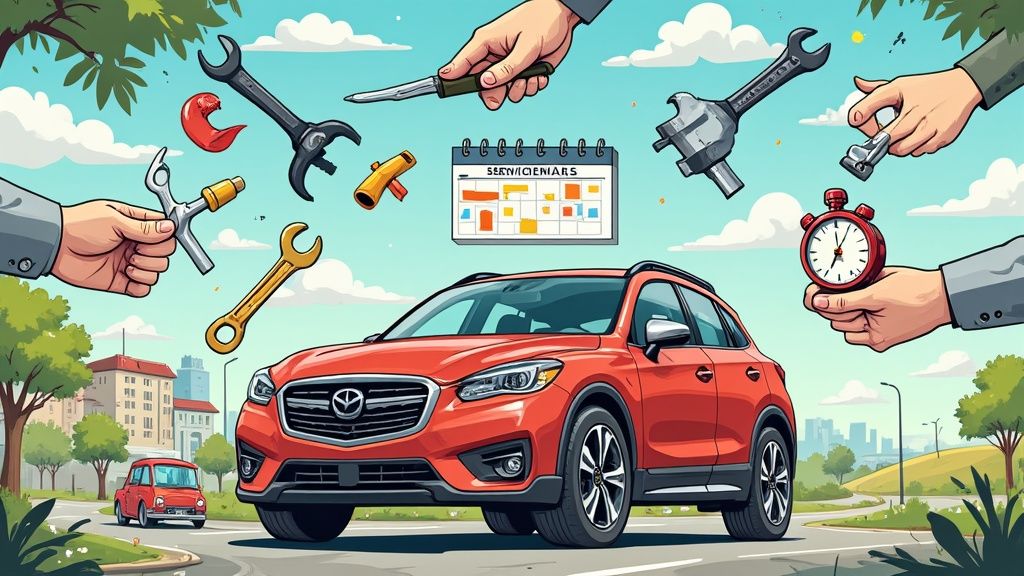
How Often Should You Service Your Car? The Essential Guide to Smart Maintenance
The Hidden Cost of Neglected Car Maintenance
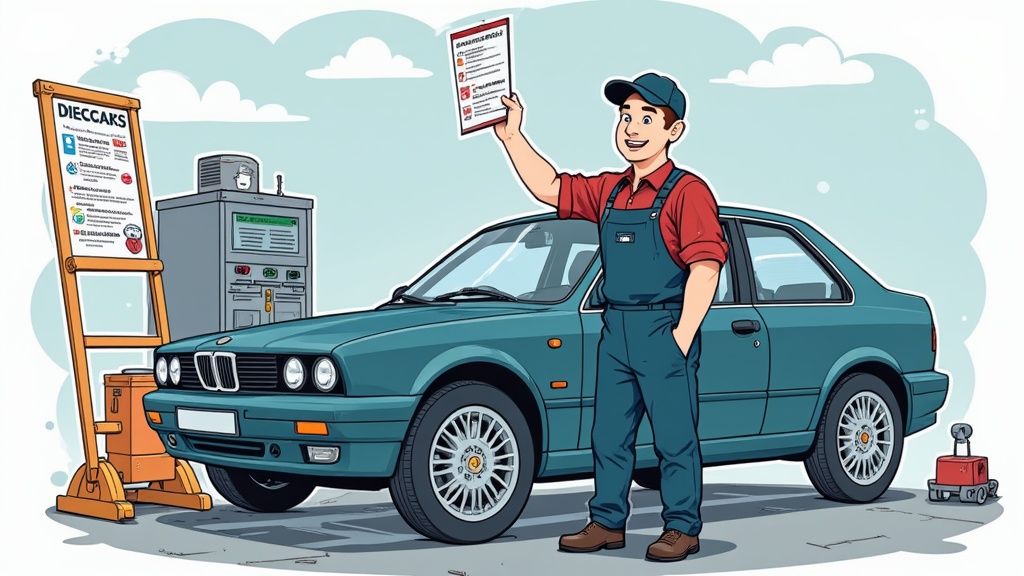
Car maintenance isn’t just another item on your to-do list - it’s an essential investment that protects both your safety and your bank account. What might seem like minor maintenance tasks today can spiral into major expenses if ignored. Take oil changes, for example - skipping them may save a few dollars now, but can lead to severe engine damage requiring costly repairs later. Understanding your car’s service needs is key to avoiding these expensive surprises.
The Price of Procrastination: Real-World Examples
Let’s look at what happens when basic maintenance gets pushed aside. Many drivers put off regular tire rotations, not realizing this simple oversight leads to uneven wear patterns that force early tire replacement - a much bigger expense than routine rotations would have been. Similarly, when brake maintenance is delayed, worn pads can damage the rotors, turning what could have been a simple pad replacement into a major brake system repair.
The cooling system offers another clear example. Regular coolant flushes help prevent corrosion and overheating. Skip these services, and you risk serious engine damage that could cost thousands to fix. These real situations show how small maintenance costs can multiply into major repairs when ignored.
Beyond the Wallet: Safety and Performance
Poor maintenance affects more than just repair costs - it creates real safety risks. Worn brakes mean longer stopping distances and potential brake failure. Neglected steering and suspension parts can make your car harder to control, especially in emergency situations where quick reactions matter most.
Regular maintenance also keeps your car running at its best. Clean oil helps maintain engine efficiency and fuel economy, while fresh air filters ensure proper airflow for optimal performance. By following the recommended service schedule, you’re investing in both safety and driving enjoyment.
Preventing Problems Before They Start
How do you avoid these hidden costs? While service needs vary by vehicle type, driving habits, and environment, your owner’s manual provides a solid maintenance timeline to follow. This schedule maps out when to change fluids, replace filters, rotate tires, and perform other key services. You might be interested in: How to master your car’s maintenance.
Stay alert for warning signs like unusual noises, vibrations, or changes in how your car drives. Addressing these early warning signals helps prevent small issues from becoming major problems. With consistent maintenance and prompt attention to potential issues, you can protect your investment and keep your car reliable for years to come.
Mastering Your Vehicle’s Maintenance Timeline
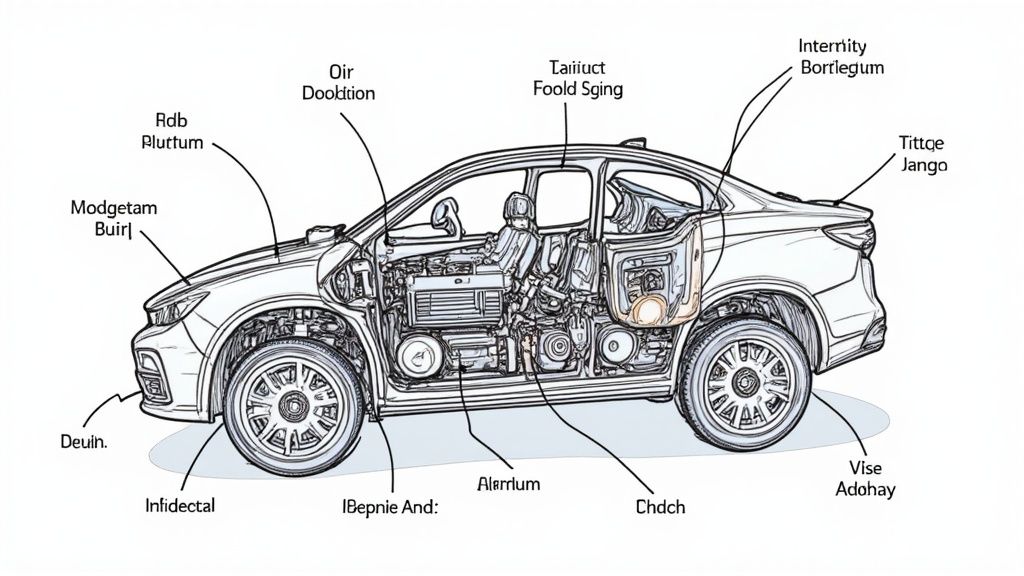
Regular car maintenance is essential for avoiding expensive repairs, but knowing when to service your vehicle is just as important as understanding why you need to do it. Here’s what you need to know about creating an effective maintenance schedule that will keep your car running smoothly for years to come.
Decoding the Manufacturer-Recommended Service Intervals
Your owner’s manual is your best guide for understanding service timing. Car manufacturers create detailed maintenance schedules for each model based on specific factors like engine type, typical driving conditions, and built-in technology. For instance, a high-performance sports car that’s driven aggressively needs different service intervals compared to an economy car used mainly for commuting.
The Evolution of the 30-60-90 Rule
While older vehicles often followed the 30-60-90 maintenance rule (services at 30,000, 60,000, and 90,000 miles), today’s cars are different. Modern engineering and synthetic oils mean many vehicles can go longer between services. The 30-60-90 guideline can still be useful, but blindly following it without checking your manual could result in unnecessary work or missed maintenance needs.
Beyond the Manual: Tailoring Your Maintenance to Your Driving Style
Your specific driving habits should influence your service schedule beyond what the manual suggests. City drivers dealing with frequent stops and starts face different maintenance needs than those who mainly drive highway miles. Factors like extreme weather, dusty conditions, or regular towing put extra stress on your vehicle. For example, if you mostly drive in heavy city traffic, your brakes and transmission may need more frequent checks than the standard schedule recommends.
Real-World Maintenance Calendars: Examples for Different Driving Styles
Let’s look at how different driving patterns affect maintenance timing. A city driver should get more frequent oil changes and brake inspections due to stop-and-go conditions. Highway drivers can usually stick closer to standard service intervals but might need more frequent tire rotations from sustained high speeds.
| Driving Style | Oil Change | Brake Inspection | Tire Rotation |
|---|---|---|---|
| Primarily City Driving | Every 5,000 miles | Every 6 months | Every 10,000 miles |
| Primarily Highway Driving | Every 7,500 miles | Every 12 months | Every 5,000 miles |
| Heavy Towing/Off-Roading | Every 3,000 miles | Every 3 months | Every 5,000 miles |
Keeping detailed records of your mileage and watching how your car performs helps identify potential issues early. Many drivers find that using Auto Service Logger makes it easy to track maintenance and stay on schedule. By paying attention to your car’s needs and following a personalized service plan, you can avoid unnecessary repairs while ensuring reliable performance over time.
Strategic Planning for Essential Service Tasks
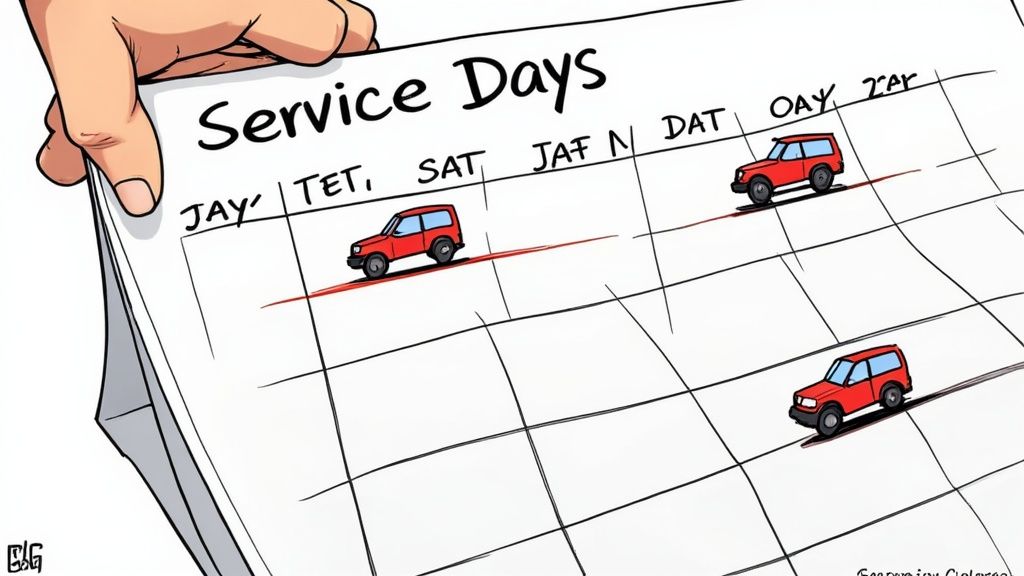
Smart service planning goes beyond knowing basic maintenance schedules - it requires understanding how to manage tasks effectively. The frequency of car service depends on several key factors: your manufacturer’s guidelines, how you drive, and your ability to spot and address problems early.
Prioritizing Your Car’s Vital Components
Your car operates as an interconnected system where each part plays a crucial role. Regular maintenance of essential components prevents breakdowns and extends your vehicle’s life. Take oil changes, for instance - they’re not optional but fundamental to protecting your engine. Fresh oil keeps parts properly lubricated and prevents wear that could lead to expensive repairs. Similarly, keeping up with brake maintenance isn’t just about safety - it helps you avoid costly rotor replacements and other major repairs down the road.
Identifying Warning Signs and Taking Action
While following maintenance schedules is essential, paying attention to your car’s signals is just as important. Never ignore unusual sounds, odd vibrations, or changes in how your car handles. These early signs often point to developing issues that are much easier and cheaper to fix when caught early. Consider using tools like Auto Service Logger to track your car’s service history. Good record-keeping helps you spot patterns and address potential problems before they become serious repairs.
Practical Frameworks for Managing Multiple Maintenance Items
Keeping track of various maintenance tasks doesn’t have to be complicated. Break down your maintenance plan into smaller, manageable steps, similar to how you’d organize any other project. Use a maintenance calendar or smartphone app to schedule services, set alerts, and document completed work. This organization creates a valuable history of your car’s care. Build a relationship with a reliable mechanic who understands your specific vehicle. Regular discussions with your mechanic provide insights into your car’s needs based on your driving patterns and help prioritize services effectively. This systematic approach turns car maintenance from a burden into a straightforward investment in your vehicle’s long-term health and reliability.
Building Your Maintenance Investment Strategy
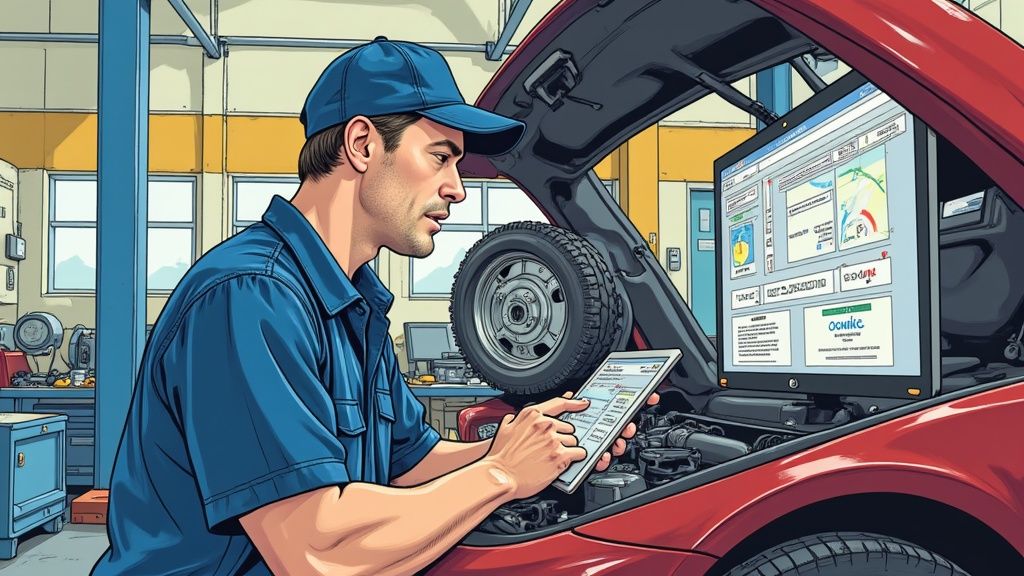
Car maintenance is best viewed as a long-term investment rather than just basic upkeep. Making the shift from fixing problems as they occur to preventing them through regular care can significantly extend your vehicle’s life while saving money. Research shows that well-timed preventive maintenance can cut lifetime vehicle costs by up to 40% - adding up to substantial savings over the years of ownership.
Preventive vs. Reactive Maintenance: A Cost-Benefit Analysis
The contrast between preventive and reactive maintenance mirrors the difference between routine dental care and emergency procedures. Regular oil changes, tire rotations and inspections catch small issues early. Waiting until something breaks, however, often leads to much costlier repairs. Take timing belts for example - replacing one according to schedule might cost a few hundred dollars, but if it snaps, the resulting engine damage could run into thousands.
Budgeting for Routine and Major Services
Smart maintenance budgeting requires planning for both regular upkeep and larger repairs. Oil changes, filter replacements and other routine services follow predictable schedules with manageable costs. Major work like transmission repairs or timing belt replacements happens less often but costs significantly more. To handle both types of expenses, set up a dedicated maintenance fund with regular contributions. This ensures you’re prepared for scheduled services while building a reserve for bigger repairs. For more guidance, check out: How to master your car’s maintenance.
Maximizing Your Return on Maintenance Investment
Different maintenance needs arise at different points in a vehicle’s life. For newer cars, following the manufacturer’s service schedule protects your warranty and future resale value. As mileage increases, focus shifts to maintaining critical systems like brakes, suspension and cooling to prevent major failures. Simple services like coolant flushes prevent engine corrosion - much cheaper than replacing a damaged engine. Even seemingly expensive choices like premium tires can save money long-term through better fuel economy and longer wear.
Real-World Examples: Investing in Longevity
Consider two identical cars with different maintenance approaches. The owner who follows recommended service schedules typically experiences fewer breakdowns, gets better resale value, and spends less overall compared to one who only fixes problems after they occur. This clearly shows how viewing maintenance as an investment rather than an expense leads to both better reliability and lower long-term costs. With consistent preventive care, you’ll enjoy more dependable transportation while protecting your vehicle’s value.
Overcoming Common Maintenance Challenges
Regular car maintenance can feel overwhelming when juggling busy schedules and tight budgets. Still, having a consistent care routine is essential for both safety and long-term savings. Let’s explore practical ways to handle the most common maintenance hurdles.
Tackling Scheduling Conflicts
Finding time for car maintenance can be challenging with packed calendars. The key is treating these appointments like other important commitments - schedule them well in advance and set clear reminders. For instance, block off time for an oil change just as you would for a medical checkup. Many service centers now offer extended evening and weekend hours to help accommodate your schedule. Being proactive about planning makes it much easier to stay on track with needed maintenance.
Managing Budget Constraints
The cost of car maintenance often deters people from keeping up with recommended services. However, skipping routine care usually leads to much bigger repair bills down the road. Think of maintenance as an investment that helps prevent expensive problems. Setting up a dedicated car care savings account and making small regular deposits can help make larger service costs more manageable. You might be interested in: How to master your car’s maintenance.
Simplifying the Tracking Process
Keeping tabs on multiple maintenance items across one or more vehicles quickly becomes complex. Digital tools like Auto Service Logger make this much simpler by providing a central place to log service dates, mileage, and receipts. Having all maintenance records easily accessible eliminates paper files and helps you stay organized. For families with multiple cars, these platforms allow tracking all vehicles in one convenient location.
Finding Reliable Service Providers
Working with a trustworthy mechanic is key to hassle-free car maintenance. A good service provider not only does quality work but offers honest advice about which services are truly needed. Ask friends, family and local community groups for recommendations. Once you build a relationship with a reliable mechanic, the entire maintenance process becomes smoother and less stressful.
Dealing With Unexpected Repairs
Even with regular maintenance, surprise repairs sometimes happen. Having a plan in place helps minimize both stress and financial strain. Consider building an emergency fund specifically for car repairs or researching financing options through your mechanic or credit union ahead of time. While unexpected issues are never fun, being prepared makes them much more manageable. By addressing these common challenges proactively, car maintenance becomes less of a burden and more of a routine investment in your vehicle’s reliability and longevity. With some strategic planning, you can develop sustainable habits that keep your car running smoothly for years to come.
Creating Your Personal Service Success Plan
A well-organized car maintenance routine doesn’t have to be overwhelming. With a thoughtful service plan tailored to your specific needs, you can transform car maintenance from a source of stress into a smooth, manageable process.
Understanding Your Vehicle and Driving Habits
Every car needs its own customized maintenance approach, much like how each person has unique health requirements. While your owner’s manual provides baseline service intervals, these are just general guidelines. Your actual maintenance needs depend heavily on how you use your vehicle. For instance, city driving with frequent stops puts more wear on brakes compared to highway cruising. Similarly, regularly hauling heavy loads or making many short trips can mean your car needs more frequent service than standard recommendations suggest.
Using Digital Tools to Stay Organized
Keeping track of multiple maintenance tasks can quickly become complex, especially if you own more than one vehicle. This is where Auto Service Logger becomes incredibly helpful. You can easily record service dates, track mileage, store receipts digitally, and set up maintenance reminders. Having all your car’s service history in one accessible place eliminates paper clutter and proves invaluable when dealing with warranty claims or selling your vehicle. Plus, this detailed record helps mechanics diagnose issues more accurately since they can see your car’s full maintenance history.
Building a Relationship With Your Service Provider
Finding a trustworthy mechanic forms the foundation of effective car maintenance. A good mechanic does more than just fix problems - they become a partner in maintaining your vehicle’s health. They can help you understand which services your car needs based on your specific driving patterns and vehicle condition. Through open communication, they’ll help you prioritize maintenance tasks appropriately, avoiding unnecessary work while ensuring important services aren’t missed.
Developing Your Personalized Checklist and Recognizing Warning Signs
While digital tools handle record-keeping, having your own maintenance checklist serves as a practical daily reminder. Create a simple spreadsheet or use a template that includes all necessary tasks based on your car’s needs and manufacturer guidelines. Beyond scheduled maintenance, pay attention to how your car feels and sounds. Just as a small roof leak is easier to fix than extensive water damage, addressing early warning signs like unusual noises or vibrations prevents minor issues from becoming major repairs. Stay alert to these signals - they’re your car’s way of communicating potential problems before they become serious.
Ready to take control of your car maintenance and experience the peace of mind that comes with organized and efficient record-keeping? Try Auto Service Logger today and simplify your car care journey!